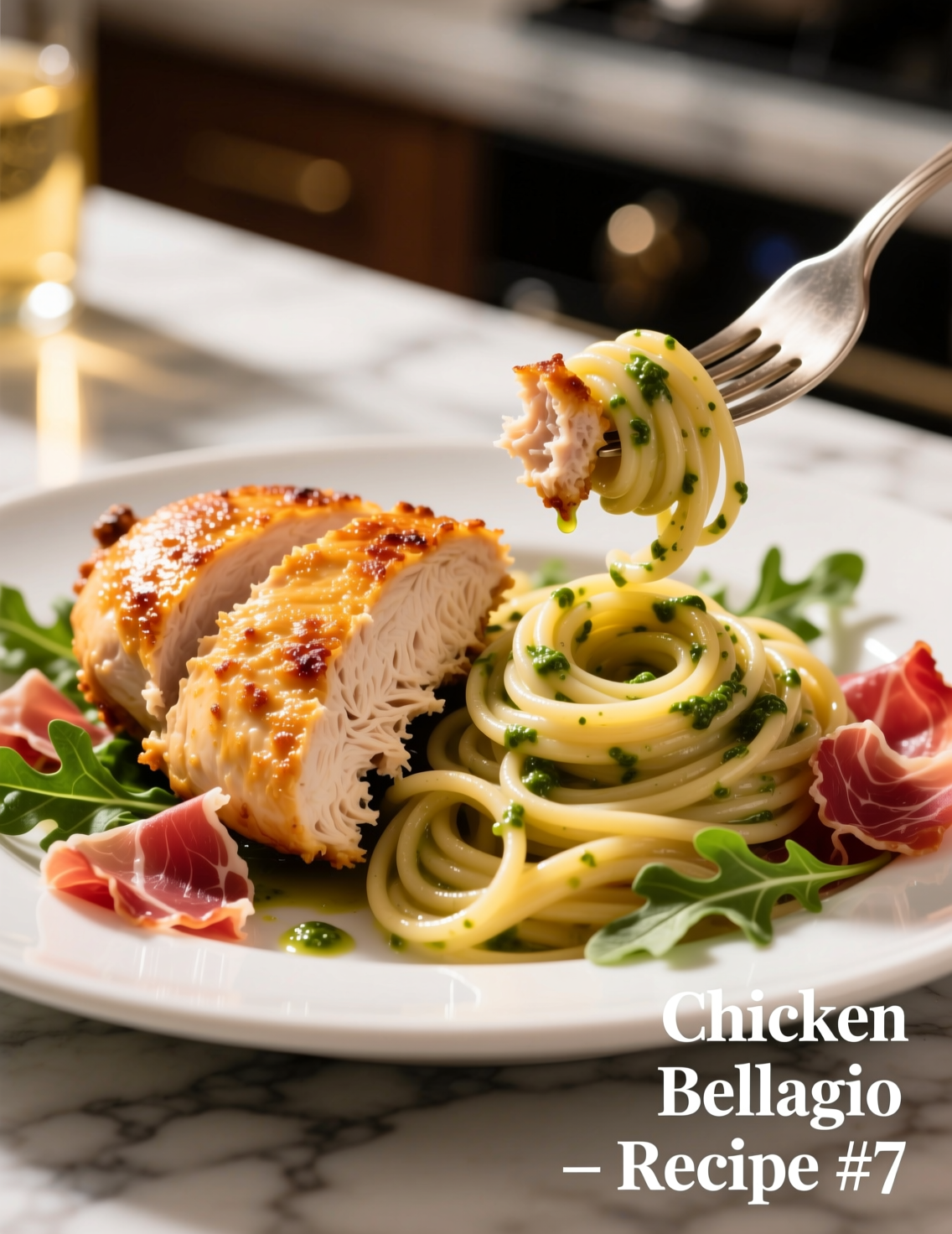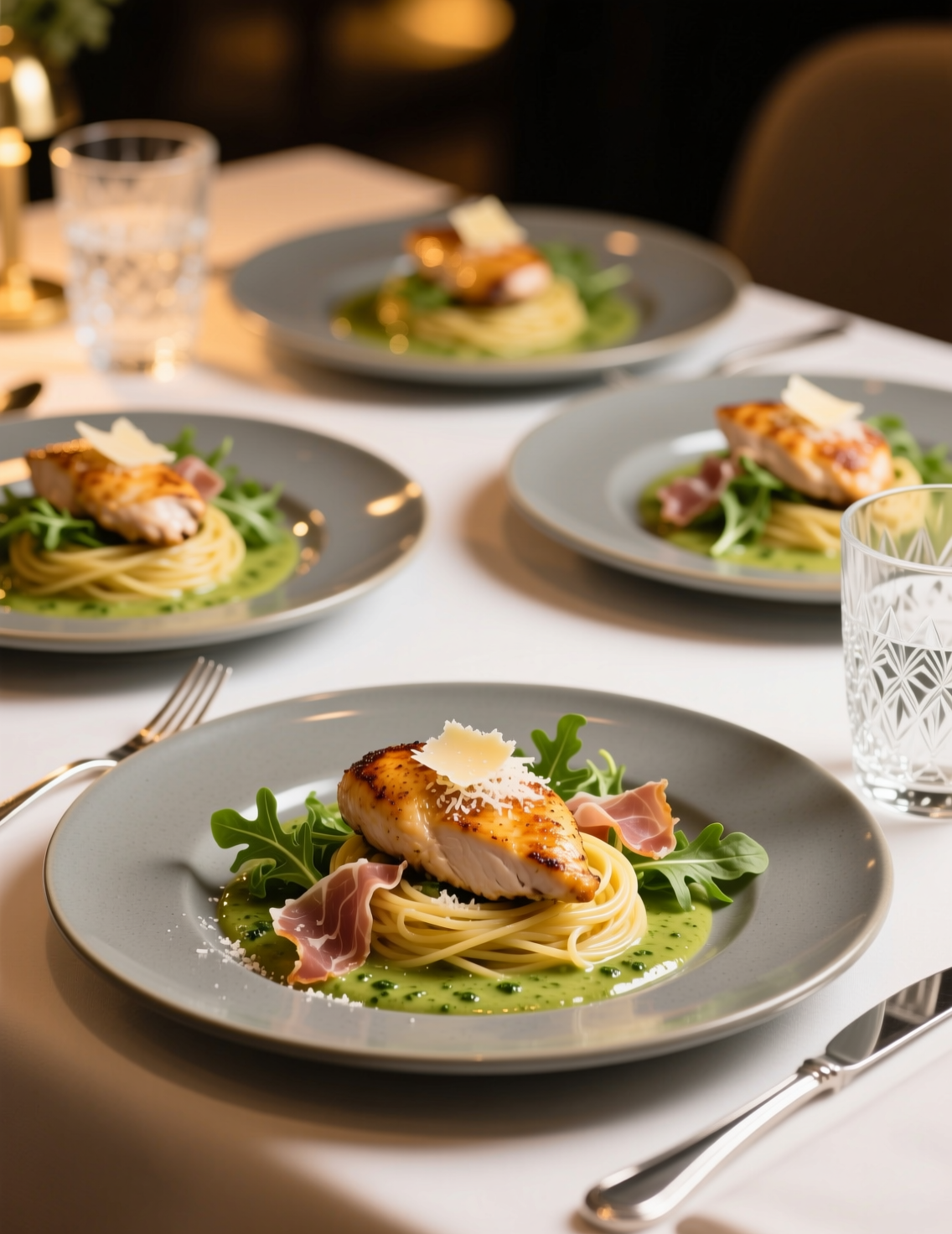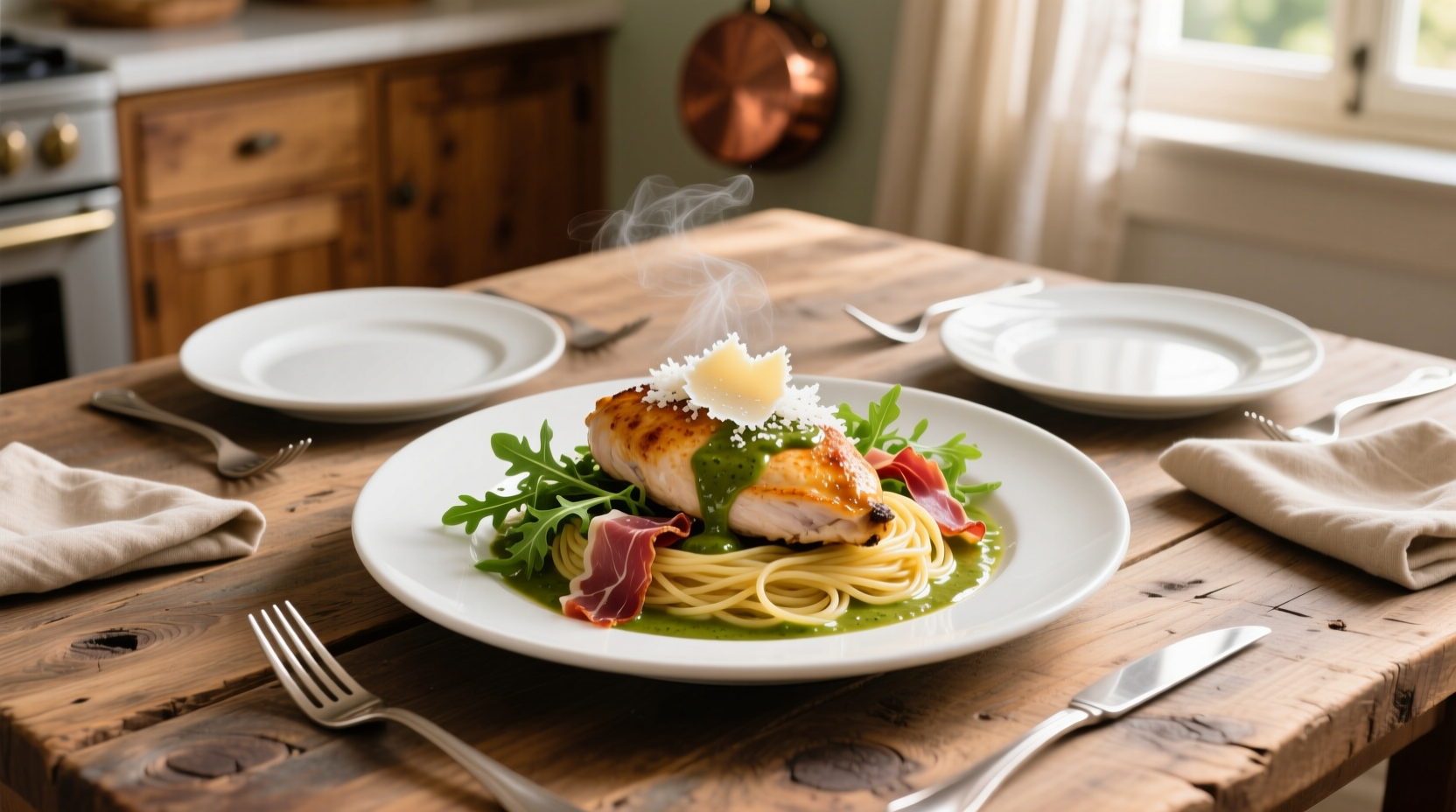There are recipes that sit in the background like a quiet accompanist, and then there’s Chicken Bellagio. This dish, popularized by The Cheesecake Factory, has managed to become both a comfort food and a dinner showpiece. It blends crisp golden chicken, tender pasta, creamy Parmesan sauce, and the herby brightness of pesto into something greater than the sum of its parts. Cooking it at home for four servings requires not just a recipe but a touch of culinary reasoning, a bit of science, and a few tricks tucked in your apron pocket. That’s where we dig in.
What Exactly Is Chicken Bellagio
At its heart, Chicken Bellagio is pan-fried chicken breast layered over a bed of spaghetti tossed with Parmesan cream sauce and fresh basil pesto. A slice of prosciutto crowns the chicken like a final garnish of elegance. The dish was designed to play on contrasts: crispy vs. creamy, salty vs. fresh, indulgent vs. bright. Professionals often note how it balances richness with green vibrance—something not all pasta-based entrees achieve.
Restaurants lean heavily on butter, cream, and cheese to get flavor depth, but at home, you control every ratio. That’s where this recipe stands out: it isn’t just copying a restaurant dish—it’s optimizing it.
Ingredients for 4 Servings
Precision matters. If your mise en place is sloppy, your timing will tumble. Below is the professional breakdown:
- 4 boneless, skinless chicken breasts (around 6 oz each, pounded to ½ inch thick)
- 1 cup all-purpose flour, seasoned lightly with salt and pepper
- 2 large eggs, beaten with 1 tbsp water (for dredging)
- 1 ½ cups panko breadcrumbs (for the crunch that won’t fade fast)
- ½ cup grated Parmesan cheese (folded into the breadcrumbs)
- Olive oil for shallow frying (about ½ cup, depending on pan size)
- 12 oz spaghetti (dry weight)
- 1 cup heavy cream
- 1 cup chicken stock (preferably homemade for rounder mouthfeel)
- 1 tbsp unsalted butter
- 1 garlic clove, finely minced
- ½ cup Parmesan cheese (extra for sauce)
- ½ cup fresh basil pesto (homemade is leagues better than store-bought)
- 4 slices prosciutto
- Fresh basil leaves for garnish
- Salt and black pepper to taste
The list may look long, but each element has a job. Remove one, and you tilt the balance off center.

Step-by-Step Cooking Method
1. Prepping the Chicken
Chefs always pound chicken breasts to an even thickness. This isn’t for aesthetics. Uniform thickness guarantees even cooking, and avoids that dreaded half-raw, half-dry result. After pounding, dredge the breasts in flour, dip in egg wash, then coat with the Parmesan-panko mix. The double flavor layer means the crust sings rather than just crunches.
2. Frying to Perfection
Shallow-fry in olive oil over medium heat. Too hot, and the breadcrumbs scorch while the meat stays raw inside. Too cold, and oil seeps into the crust, leaving a soggy mess. Professionals often check with a thermometer—aim for 340°F to 350°F. Each side takes about 4 minutes. Rest the chicken on a wire rack, not paper towels. Paper steams the crust, racks preserve it.
3. The Sauce That Holds It All
In a sauté pan, melt butter and cook garlic until fragrant but not browned. Add chicken stock and reduce slightly. Pour in heavy cream, simmer gently, and whisk in Parmesan. You’re building an emulsion here—fat, liquid, and solids working in tension. Overheat it and it splits, under-reduce it and it’s watery. Aim for nappe consistency, where the sauce lightly coats the back of a spoon. Professionals always test this by swiping a finger across the spoon; if the line holds clean, the sauce is ready.
4. The Pasta
Spaghetti should be cooked al dente in generously salted water. Salted water is not negotiable—it seasons the pasta from within. Drain and toss immediately with half of the pesto and the Parmesan cream sauce. Save some sauce for plating; pasta soaks it up quickly like a thirsty sponge.
5. Assembly
Twirl a nest of spaghetti onto each plate. Lay one golden chicken breast on top. Drizzle the remaining pesto around, place a slice of prosciutto over the chicken, and finish with basil leaves. It’s a dish that must be plated with intention. Messy piles won’t cut it.
The Science Behind the Flavors
Chicken Bellagio isn’t just indulgent—it’s culinary engineering. The crispy crust contrasts the creamy pasta because of starch gelatinization in breadcrumbs. The cream sauce emulsifies fat and water to create silkiness, and basil pesto adds volatile oils from basil that brighten the heavy dairy. Even the prosciutto isn’t arbitrary—it provides glutamates that heighten umami.
Studies on food pairing show that fat and salt extend the persistence of flavors on the tongue. That’s why one bite feels longer-lasting than, say, a simple grilled chicken breast. Restaurants exploit this heavily; at home, we get to understand it.
Professional Insights and Variations
Chefs don’t follow recipes blindly. They adapt based on context.
- For a lighter take, replace half the cream with whole milk but maintain the Parmesan quantity.
- Gluten-free? Use rice flour for dredging and gluten-free panko.
- Swap spaghetti for angel hair if service speed matters—angel hair cooks in half the time.
- Prosciutto can be crisped in the oven at 375°F for 8 minutes, adding textural play instead of delicate chew.
One of the most interesting professional tweaks I’ve seen is using a basil-walnut pesto instead of the classic pine nut version. Walnuts introduce a slightly tannic finish, cutting through the creaminess like a subtle chisel.
Common Misconceptions
People assume more cream equals better sauce. It doesn’t. Excess cream dulls the impact of Parmesan and garlic. Sauce is about balance, not sheer volume. Another misconception is that you can skip dredging flour. Without it, the crust doesn’t adhere properly, and you end up with patchy breading. Finally, reheating this dish in the microwave? Don’t. The crust sogs, the sauce splits. If leftovers exist, reheat in a low oven, sauce in a saucepan separately.

Pairing and Service
Chicken Bellagio pairs beautifully with light-bodied whites like Pinot Grigio or a crisp Sauvignon Blanc. Sparkling water with lemon also works as a palate cleanser between bites, especially since the dish leans rich. Side vegetables should be simple—steamed asparagus or roasted cherry tomatoes. Don’t overcomplicate; the main dish is already the show.
Emerging Trends Around Dishes Like This
There’s a rising movement of “restaurant recreation” cooking. Dishes like Chicken Bellagio represent a kind of culinary nostalgia—people want the restaurant experience without leaving home. On TikTok alone, recipe recreations rack millions of views, with Chicken Bellagio consistently appearing in viral cooking content. Professionals note that younger home cooks especially enjoy dishes that look visually impressive but follow straightforward cooking mechanics. Bellagio ticks every box: crispy golden meat, green sauces, twirls of pasta.
Nutrition and Practical Notes
Not surprisingly, the dish is calorie dense. A single serving can run between 900–1,200 calories depending on sauce ratios. For health-conscious diners, reducing portion sizes or balancing with fresh greens helps. Adding lemon zest into the pesto is another strategy—it introduces freshness without more fat. Professionals often scale portioning slightly smaller when serving at catered events, treating Chicken Bellagio as more of a plated entrée than a heaping dinner.
Final Thoughts
Chicken Bellagio is more than just a Cheesecake Factory menu item. It’s a lesson in contrasts, in plating intention, in balancing richness with vibrancy. For professionals, it’s an example of how restaurant dishes can be adapted at home with precision and understanding. For home cooks, it’s a chance to practice breading technique, sauce emulsification, and plating finesse all in one dish.
Cook it with patience, plate it with respect, and it becomes more than dinner—it’s an education.
FAQs
What is Chicken Bellagio?
Chicken Bellagio is a restaurant-style dish with crispy chicken, creamy Parmesan pasta, basil pesto, and prosciutto.
How many servings does this recipe make?
The recipe is designed for 4 servings.
Can I use store-bought pesto?
Yes, but homemade pesto offers fresher flavor and better texture.
What pasta works best for Chicken Bellagio?
Spaghetti is traditional, but angel hair or linguine can also be used.
How do I keep the chicken crispy?
Rest fried chicken on a wire rack instead of paper towels to prevent sogginess.
Can I make the dish lighter?
Replace half the cream with milk and keep the Parmesan amount the same.
Is prosciutto necessary?
It adds salty umami depth, but you can omit or crisp it for a twist.
How should leftovers be reheated?
Reheat chicken in the oven and sauce separately on the stove for best texture.
What wine pairs well with Chicken Bellagio?
A crisp Pinot Grigio or Sauvignon Blanc balances the richness nicely.
Is this dish gluten-free?
Use rice flour and gluten-free panko for dredging, plus gluten-free pasta.

Mariana is a passionate home cook who creates delicious, easy-to-follow recipes for busy people. From energizing breakfasts to satisfying dinners and indulgent desserts, her dishes are designed to fuel both your body and hustle.
When she’s not in the kitchen, she’s exploring new flavors and dreaming up her next recipe to share with the Foodie Hustle community.

